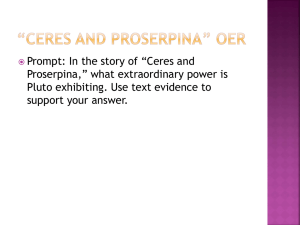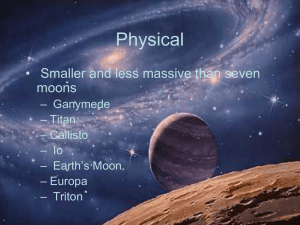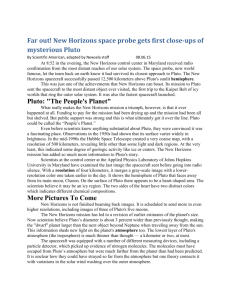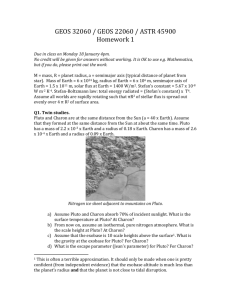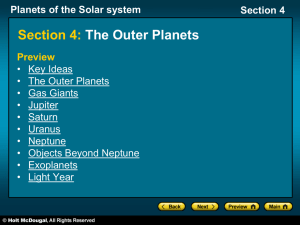Pluto naomi
advertisement
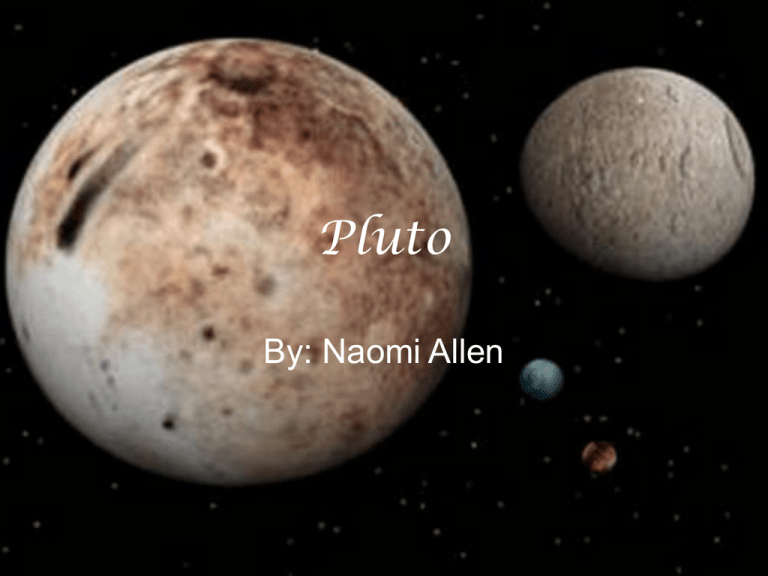
Pluto By: Naomi Allen What does “Pluto" mean? • Pluto-Roman Mythology The god of the dead and the ruler of the underworld. • A dwarf planet that until 2006 was classified as the ninth planet in our solar system, having a sidereal period of revolution about the sun of 248.5 years, 4.4 billion kilometers (2.8 billion miles) distant at perihelion and 7.4 billion kilometers (4.6 billion miles) at aphelion, and a diameter less than half that of Earth. • 2. All eight planets and some moons were named after a mythological god or goddess. Pluto and it’s surroundings When it is outside Neptune's Orbit, it is 8 planets away from the Sun and when it is inside Neptune's Orbit, it is 7 planets away from the Sun. Pluto has a very eccentric orbit and spends 20 year chunks of time closer to the Sun than Neptune. it takes About 6 earth days for Pluto to rotate in its own axis The 411 on Pluto • It takes About 6 earth days for Pluto to rotate in its own axis • The diameter of the planet Pluto is 2390 kilometers. • The mass of the planet Pluto is 0.0125 * 1024 kilograms. • Pluto is technically the smallest planet • The force of gravity on the surface of Pluto is 1/15 of what it is on the surface of the Earth. This means that a person who weighs 150 lb on Earth would weigh 10 lb on Pluto. • Pluto takes about 247.92 Earth years to complete one orbit around the Sun What are you made of? • Pluto's composition is not very well known since it is so far away from Earth. Astronomers believe that it's mostly made of rock and frozen methane, water, nitrogen and carbon dioxide. This is probably covered by a thin atmosphere of methane Gas. • The mean temperature on Pluto is -225°C (373°F). • The mean temperature on Earth is 15°C (59°F). • Pluto is a kind of icy planet How to see it • While Pluto's internal composition is unknown, Hubble Space Telescope observations suggest that the planet's density lies between 1.8 and 2.1 gm/cm3 which indicate that the planet is probably a mixture of 50 to 70 percent rock with the remainder being water and other ices much like Neptune’s moon Triton. • Pluto's composition is not very well known since it is so far away from Earth. Astronomers believe that it's mostly made of rock and frozen methane, water, nitrogen and carbon dioxide. This is probably covered by a thin atmosphere of methane gas. Can You live here? • Pluto has three known moons. The largest, Charon, is proportionally larger, compared to its primary, than any other satellite of a known planet or dwarf planet in the solar system. The other two moons, Nix and Hydra, are much smaller. • Pluto has no known rings. • not very well. There would be minimal sunlight so you would be unable to grow anything, the surface temperature varies between -235 and -210 degrees Celsius, there is no liquid water, the atmosphere when it is not frozen would kill you in seconds, and the gravity is only 7% that of earth. Got Moons? • Pluto has 3 moons. They took a long time to discover because they're so tiny. Nix is only 46 km across, while Hydra is 61 km across. When and who • Pluto was discovered by the astronomer Clyde W. Tombaugh at the Lowell Observatory in Arizona on February 18, 1930 when he was comparing photographic plates taken on January 23rd and 29th. A little something special •PLUTO THE DWARF PLANET! Credits • This power point was edited and created by the one and only Naomi Allen and with have some help from Microsoft word and Google images, I have created a wonderful power point all about PLUTO. Pluto is a very special planet to me and deserves just as much attention as any other real planet, because even though us little people or planets are small we can do big things!
